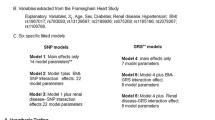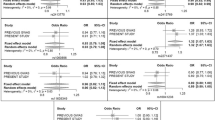Abstract
The Arg64 allele of variant rs4994 (Trp64Arg) in the β3-adrenergic receptor gene has been associated with increased serum urate and risk of gout. Our objective was to investigate the relationship of rs4994 with serum urate and gout in New Zealand European, Māori and Pacific subjects. A total of 1730 clinically ascertained gout cases and 2145 controls were genotyped for rs4994 by Taqman®. Māori and Pacific subjects were subdivided into Eastern Polynesian (EP) and Western Polynesian (WP) sample sets. Publicly available genotype data from the Atherosclerosis Risk in Communities Study and the Framingham Heart Study were utilized for serum urate association analysis. Multivariate logistic and linear regression adjusted for potential confounders was carried out using R version 2.15.2. No significant association of the minor Arg64 (G) allele of rs4994 with gout was found in the combined Polynesian cohorts (OR = 0.98, P = 0.88), although there was evidence, after adjustment for renal disease, for association in both the WP (OR = 0.53, P = 0.03) and the lower Polynesian ancestry EP sample sets (OR = 1.86, P = 0.05). There was no evidence for association with gout in the European sample set (OR = 1.11, P = 0.57). However, the Arg64 allele was positively associated with urate in the WP data set (β = 0.036, P = 0.004, P Corrected = 0.032). Association of the Arg64 variant with increased urate in the WP sample set was consistent with the previous literature, although the protective effect of this variant with gout in WP was inconsistent. This association provides an etiological link between metabolic syndrome components and urate homeostasis.


Similar content being viewed by others
References
Dalbeth N, Merriman T (2009) Crystal ball gazing: new therapeutic targets for hyperuricaemia and gout. Rheumatology 48:222–226
Kottgen A, Albrecht E, Teumer A, Vitart V, Krumsiek J, Hundertmark C et al (2013) Genome-wide association analyses identify 18 new loci associated with serum urate concentrations. Nat Genet 45:145–154
Phipps-Green A, Merriman M, Topless R, Altaf S, Montgomery G, Franklin C et al (2014) Twenty-eight loci that influence serum urate levels: analysis of association with gout. Ann Rheum Dis. doi:10.1136/annrheumdis-2014-205877
Choi HK, Ford ES (2007) Prevalence of the metabolic syndrome in individuals with hyperuricemia. Am J Med 120:442–447
Choi HK, Ford ES, Li C, Curhan G (2007) Prevalence of the metabolic syndrome in patients with gout: the Third National Health and Nutrition Examination Survey. Arthritis Care Res 57:109–115
Facchini F, Chen Y-DI, Hollenbeck CB, Reaven GM (1991) Relationship between resistance to insulin-mediated glucose uptake, urinary uric acid clearance, and plasma uric acid concentration. JAMA 266:3008–3011
Lyngdoh T, Vuistiner P, Marques-Vidal P, Rousson V, Waeber G, Vollenweider P et al (2012) Serum uric acid and adiposity: deciphering causality using a bidirectional Mendelian randomization approach. PLoS One 7:e39321
Rasheed H, Hughes K, Flynn TJ, Merriman TR (2014) Mendelian randomisation provides no evidence for a causal role of serum urate in increasing serum triglyceride levels. Circ Cardiovasc Genet 7:830–837
Krief S, Lönnqvist F, Raimbault S, Baude B, Van Spronsen A, Arner P et al (1993) Tissue distribution of beta 3-adrenergic receptor mRNA in man. J Clin Invest 91:344–349
Kurokawa N, Young EH, Oka Y, Satoh H, Wareham NJ, Sandhu M et al (2008) The ADRB3 Trp64Arg variant and BMI: a meta-analysis of 44,833 individuals. Int J Obes 32:1240–1249
Gjesing A, Andersen G, Borch-Johnsen K, Jørgensen T, Hansen T, Pedersen O (2008) Association of the β3-adrenergic receptor Trp64Arg polymorphism with common metabolic traits: studies of 7605 middle-aged white people. Mol Genet Metab 94:90–97
Widen E, Lehto M, Kanninen T, Walston J, Shuldiner AR, Groop LC (1995) Association of a polymorphism in the β3-adrenergic–receptor gene with features of the insulin resistance syndrome in Finns. N Engl J Med 333:348–352
Strazzullo P, Iacone R, Siani A, Cappuccio FP, Russo O, Barba G et al (2001) Relationship of the Trp64Arg polymorphism of the beta3-adrenoceptor gene to central adiposity and high blood pressure: interaction with age. Cross-sectional and longitudinal findings of the Olivetti Prospective Heart Study. J Hypertens 19:399–406
Wang G, Li Q, Niu T, Chen C, Xu X (2002) Association of GYS1 and beta (3)-AR gene with postprandial hyperglycemia and serum uric acid in type 2 diabetes mellitus. Chin Med J 115:1308–1311
Rho YH, Choi SJ, Lee YH, Ji JD, Song GG (2007) The association between hyperuricemia and the Trp64Arg polymorphism of the beta-3 adrenergic receptor. Rheumatol Int 27:835–839
Huang Q, Zhang L-F, Cheng Y, Zhao Y-C, Si L, Gao Y et al (2013) Trp64Arg (rs4994) polymorphism of β3-adrenergic receptor gene is associated with hyperuricemia in a Chinese male population. Clin Chem Lab Med 51:1755–1760
Morcillo S, Rojo-Martínez G, Martín-Núñez GM, Gómez-Zumaquero JM, García-Fuentes E, de Adana MR et al (2010) Trp64Arg polymorphism of the ADRB3 gene predicts hyperuricemia risk in a population from southern Spain. J Rheumatol 37:417–421
Wang B, Meng D, Wang J, Jia Z, Zhoub S, Liu S et al (2011) Positive correlation between Beta-3-Adrenergic Receptor (ADRB3) gene and gout in a Chinese male population. J Rheumatol 38:738–740
Winnard D, Wright C, Jackson G, Gow P, Kerr A, McLachlan A et al (2013) Gout, diabetes and cardiovascular disease in the Aotearoa New Zealand adult population: co-prevalence and implications for clinical practice. NZ Med J. 126:53–64
Winnard D, Wright C, Taylor WJ, Jackson G, Te Karu L, Gow PJ et al (2012) National prevalence of gout derived from administrative health data in Aotearoa New Zealand. Rheumatol 51:901–909
Wallace SL, Robinson H, Masi AT, Decker JL, McCarty DJ, Yu TF (1977) Preliminary criteria for the classification of the acute arthritis of primary gout. Arthritis Rheum 20:895–900
Hollis-Moffatt JE, Phipps-Green AJ, Chapman B, Jones GT, van Rij A, Gow PJ et al (2012) The renal urate transporter SLC17A1 locus: confirmation of association with gout. Arthritis Res Ther 14:R92
Howie B, Marchini J, Stephens M (2011) Genotype imputation with thousands of genomes. G3: genes, genomes. Genetics 1:457–470
Team RC (2012) R: a language and environment for statistical computing. R Foundation for Statistical Computing, Vienna. ISBN 3-900051-07-0
Phipps-Green AJ, Hollis-Moffatt J, Dalbeth N, Merriman ME, Topless R, Gow PJ et al (2010) A strong role for the ABCG2 gene in susceptibility to gout in New Zealand Pacific Island and Caucasian, but not Māori, case and control sample sets. Hum Mol Genet 19:4813–4819
Savage DB, Petersen KF, Shulman GI (2005) Mechanisms of insulin resistance in humans and possible links with inflammation. Hypertension 45:828–833
Park HS, Shin ES, Lee JE (2008) Genotypes and haplotypes of β2-adrenergic receptor and parameters of the metabolic syndrome in Korean adolescents. Metabolism 57:1064–1070
Zhan S, Ho SC (2005) Meta-analysis of the association of the Trp64Arg polymorphism in the β3 adrenergic receptor with insulin resistance. Obes Res 13:1709–1719
Mark A, Rahmouni K, Correia M, Haynes W (2003) A leptin-sympathetic-leptin feedback loop: potential implications for regulation of arterial pressure and body fat. Acta Physiol Scand 177:345–349
Bedir A, Topbas M, Tanyeri F, Alvur M, Arik N (2003) Leptin might be a regulator of serum uric acid concentrations in humans. Jpn Heart J 44:527–536
Modan M, Halkin H, Karasik A, Lusky A (1987) Elevated serum uric acid—a facet of hyperinsulinaemia. Diabetologia 30:713–718
Quiñones-Galvan A, Ferrannini E (1996) Renal effects of insulin in man. J Nephrol 10:188–191
Acknowledgments
This work was supported by the Health Research Council of New Zealand, Arthritis New Zealand, New Zealand Lottery Health and the University of Otago. The authors would like to thank Jill Drake (Canterbury District Health Board), Roddi Laurence, Chris Franklin, Meaghen House (all University of Auckland) and Gabrielle Sexton (University of Otago) for recruitment. We also thank Ria Akuhata and Nancy Aupouri of NPHCT for recruitment, coordinated by Dr. Jennie Harré Hindmarsh. The Atherosclerosis Risk in Communities and Framingham Heart study analyses (Project #834) were approved by the relevant Database of Genotype and Phenotype (dbGaP; www.ncbi.nim.nih/gov/dbgap) Data Access Committees. The Atherosclerosis Risk in Communities Study is carried out as a collaborative study supported by National Heart, Lung, and Blood Institute contracts N01-HC-55015, N01-HC-55016, N01-HC-55018, N01-HC-55019, N01-HC-55020, N01-HC-55021, N01-HC-55022, R01HL087641, R01HL59367 and R01HL086694; National Human Genome Research Institute contract U01HG004402; and National Institutes of Health contract HHSN268200625226C. The authors thank the staff and participants of the ARIC study for their important contributions. Infrastructure was partly supported by Grant No. UL1RR025005, a component of the National Institutes of Health and NIH Roadmap for Medical Research. The Framingham Heart Study and the Framingham SHARe project are conducted and supported by the National Heart, Lung, and Blood Institute (NHLBI) in collaboration with Boston University. The Framingham SHARe data used for the analyses described in this manuscript were obtained through dbGaP. This manuscript was not prepared in collaboration with investigators of the Framingham Heart Study and does not necessarily reflect the opinions or views of the Framingham Heart Study, Boston University, or the NHLBI.
Funding
This study was funded by Grant 11/1075 from the Health Research Council of New Zealand.
Author information
Authors and Affiliations
Corresponding author
Ethics declarations
Conflict of interest
The authors declare that they have no conflict of interest.
Electronic supplementary material
Below is the link to the electronic supplementary material.
Rights and permissions
About this article
Cite this article
Fatima, T., Altaf, S., Phipps-Green, A. et al. Association analysis of the beta-3 adrenergic receptor Trp64Arg (rs4994) polymorphism with urate and gout. Rheumatol Int 36, 255–261 (2016). https://doi.org/10.1007/s00296-015-3370-6
Received:
Accepted:
Published:
Issue Date:
DOI: https://doi.org/10.1007/s00296-015-3370-6




